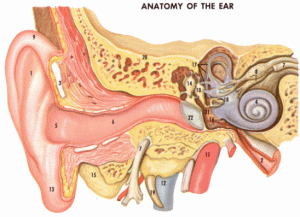
 More than a medical option – a cochlear implant is a lifetime gift of sound to a profoundly deaf. It is a powerful communication tool. It is the only medical device designed to restore a sense.A cochlear implant is the most modern treatment available for severe hearing loss. It is a small, complex electronic device that can provide sound to a profoundly deaf. Until now, deafness, caused by defects in the internal ear was believed to be permanent and not amenable to treatment. However, with the advent of CI, modern medicine has successfully found a solution. If congenital deafness is diagnosed and treated early enough, a CI can bring about a sea change in the life of a deaf person. The following pages will serve you as a guide through the first steps of the CI journey.
More than a medical option – a cochlear implant is a lifetime gift of sound to a profoundly deaf. It is a powerful communication tool. It is the only medical device designed to restore a sense.A cochlear implant is the most modern treatment available for severe hearing loss. It is a small, complex electronic device that can provide sound to a profoundly deaf. Until now, deafness, caused by defects in the internal ear was believed to be permanent and not amenable to treatment. However, with the advent of CI, modern medicine has successfully found a solution. If congenital deafness is diagnosed and treated early enough, a CI can bring about a sea change in the life of a deaf person. The following pages will serve you as a guide through the first steps of the CI journey.
What is this new technique of CI? How useful is it for the hearing impaired? What is the cost? In addition, most importantly, what are the benefits? YOU’RE NOT ALONE Hundreds of millions of people around the world experience some form of hearing loss. While many can be helped by a hearing aid, more than 75 million people still find the most powerful hearing aids inadequate.
 Structure of the Ear :
Structure of the Ear :
 Severity of Deafness :
Severity of Deafness :
Loudness of sound is measured in decibel (dB). Normal speech is heard between 10 to 40 dB over various frequency ranges. This is called as speech banana. Hearing loss of between 40 and 50 dB is called as moderate deafness; that between 50 and 70 is called as moderate to severe deafness, between 70 to 90 dB is called as severe deafness and beyond 90 dB the hearing loss is classified as profound deafness. A profoundly deaf will not be able to hear even a whistle of a nearby train also.
 Difference Between Hearing Aid and CI
Difference Between Hearing Aid and CI  What Are The Components of CI?
What Are The Components of CI?
There are two important components of a CI, the inner and the outer components. The inner component is fitted in the body by surgery. It has a magnet, a receiver-stimulator and an electrode array. The magnet and receiver-stimulator are placed behind the ear under the skin, whereas the electrode array is inserted into the cochlea during the surgery.The outer component is hooked on the pinna like a blue tooth device. It consists of a microphone, a speech processor and a transmitter coil.
As Soon As A Child Displays Symptoms of Deafness…
At the earliest, go to a centre that has all facilities to treat deafness. Confirm or rule out with certainty that the child is deaf. If the child is deaf, your ENT surgeon will be able to assess the degree, type and cause of deafness with the help of an audiologist. If the child has severe cochlear hearing loss, it is important to start hearing process at the earliest. With the help of your hearing-consultants, get a hearing aid fitted to the child. Hearing aids provide some access to sounds – and the earlier it starts the better. Begin a program of family-centred auditory therapy as soon as the first hearing aid is fitted.
at the earliest. With the help of your hearing-consultants, get a hearing aid fitted to the child. Hearing aids provide some access to sounds – and the earlier it starts the better. Begin a program of family-centred auditory therapy as soon as the first hearing aid is fitted.
This helps the child begin the process of learning to listen. Your auditory therapist’s guide will be of great help. Parents are the child’s first and most important teacher. An auditory therapist can show the parents how to help the child achieve spoken language skills and learn about the hearing world. Indorewala ENT Institute provides a range of habilitation and support materials that can be used to help begin the journey – so the whole family will be on the spoken language development path by the time the child receives a CI. It is best to get a CI surgery done within 3 months of a confirmed diagnosis.
 How Does A CI Work?
How Does A CI Work?
 What Are The Risks or Complications of CI Surgery?
What Are The Risks or Complications of CI Surgery?
Including the risks of general anaesthesia, the risks involved in this surgery are same as the risks of other ear surgeries. Deviation of face (which occurs very rarely in the hands of experienced surgeons), altered taste sensation, giddiness, and tinnitus may be a few complications.
What Tests Are Required Before Surgery?
What Preoperative Preparations Are Required?
Generally, a patient for CI is investigated thoroughly weeks prior to surgery. He/she is also vaccinated weeks prior to surgery. The patient is admitted to the hospital one day prior to surgery. Some paper work is essential. The head is generally shaved, or at least the area around the ear is shaved. The patient should remain on an empty stomach for at least 6-8 hours prior to surgery.
Can A Patient Hear Immediately After Surgery?
No, The patient cannot hear unless the external component is fitted. The external component is fitted and tuned about 20 days after surgery.
 How Is The Internal Component of The CI Placed?
How Is The Internal Component of The CI Placed?
The internal component of the CI is placed in the following stages:
The whole procedure takes about 2 to 3 hours. After 10 days, the wound heals. Once placed inside, the internal component is no more visible.
After CI Surgery When Can A Patient Go Home?
Like any ear surgery, a patient can go home next day after surgery. Patient goes home with a bandage on the ear and some medicines like painkillers and antibiotics. Patient may experience some minor pain for first 2 days after surgery. Sutures are self dissolving, thus need not be removed. The bandage is removed after 10 days.
 How Long Does It Take After Surgery To Start Speech Training?
How Long Does It Take After Surgery To Start Speech Training?
It takes about 3 weeks for the operative wound to heal, and the inflammation to subside. The external component is then fitted and speech training is started.
What Is A Basic Habilitation Program?
The basic program has three parts:
Getting adjusted to the device – The device has to be adjusted until the patient hears audible sound appropriately. Hearing tests – To verify that the tuning is accurate, and to check how the patient hears.Training on how to handle the CI, and speech training.
Does Active Co-Operation of The Patient For Speech Training Help?
Yes. Progress depends largely on the initiative taken by the patient to learn new sounds and actively take part in the training program.
How Important Is Post CI Habilitation?
Habilitation is essential for getting the best hearing and speech outcomes from a CI and sound processor. Regardless of the technology, it is well documented that successful results depend on the recipient and their audiologist, speech and language therapists, and healthcare team working together. The patient needs to be totally committed to the habilitation program.
What Is The Approximate Time Span of The Training?
The duration of training varies from patient to patient. It generally lasts for up to two years.
What Is The Caretakers’ Role In The Training Program?
It always helps to involve the caretakers in the training program as they can help the patient to better manoeuvre the speech processor.
Can The Speech Processor be Removed at Night?
Yes. The speech processor can be removed at night, and should be switched off to conserve its battery.
Can A Person Having CI Participate In Sports?
Yes. CI does not hinder participation in sports like football or tennis. However, for sports like swimming it is advisable to remove the external component before swimming.
Does The CI Need Frequent Repairs?
The internal component needs no maintenance. The external component, like any other electronic equipment, may have some problems occasionally. In addition, it is worthy to note that an expert should always perform any repairs. Do not try to repair any of the equipment on your own.
Is The Quality of Speech With CI Just Like Normal Hearing?
No. People who develop deafness after acquiring speech may find a difference in the quality of hearing. It can appear slightly unnatural or artificial. However, with continuous use one gets accustomed to the sound quality.
Which Types of Sounds Become Audible After CI?
After CI surgery most medium, loud and many soft sounds like the sound of a door closing, the sound of an engine, a telephone ring, a barking dog, the rustling of leaves, the sound of putting a light switch on, and even footsteps become audible.
Crucial Considerations…
It is vital to act early. A CI early in life can makes a huge difference. A child’s mind is programmed to learn foundational language skills during the first few years of life.So, early access to hearing will give a child a far greater chance of realizing his personal best speech and language skills.2-10 Studies have shown that children who receive a CI and appropriate habilitation at a young age (before the age of 18 months) have a greater potential to develop language skills equal to or close to those of their same aged peers with normal hearing. 3, 5, 6 & 8 While you may find it difficult to make a decision for your child, proceeding with a CI on the advice of your hearing health care team could be the greatest gift you ever provide to your child.
Can A Person Having CI Understand Speech Even Without LIP-Reading?
Many of the patients can understand speech without lip-reading. Some may need to continue lip reading, but the efficiency of lip-reading improves dramatically.
Can A Patient With CI Communicate on A Telephone?
Many patients can understand telephonic speech especially of a known person. Some patients can even understand an unknown person’s speech. However, some patients will not be able to use the telephone at all.
Are Some Sounds Painful To These Patients?
No, normally the sounds are not painful. However, if a patient experiences pain, the speech processor can be tuned again, and such sensation immediately disappears.
Will You Easy Access To Future Technology Upgrades?
Today’s implant systems are designed to let you benefit from future developments without needing any additional surgery. This is an important consideration, because you or your child will want to live with the implant you choose for a lifetime. There are many examples of recipients who had CI years ago and can still access the most advanced processors available today.
Children Who Hear And Speak…
It is documented that children who can hear and speak, develop better reading and academic skills.
This means the sooner the child can hear and use a spoken language, the more likely that he will be able to: